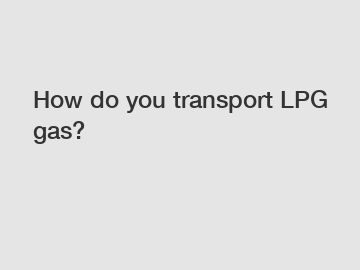How do you transport LPG gas?
How do you transport LPG gas?
LPG gas, or liquefied petroleum gas, is widely used as a clean and efficient energy source for various applications. But have you ever wondered how this versatile fuel is transported safely and efficiently? In this article, we will explore the various methods and considerations involved in transporting LPG gas.
1. Tanker Trucks:

One of the most common ways to transport LPG gas is through specialized tanker trucks. These vehicles are equipped with large tanks designed to carry the pressurized gas. The tanks are usually made of high-strength steel and are tested for safety and compliance with rigorous industry standards. Tanker trucks are commonly used for short to medium distances and are often seen on highways transporting LPG to distribution centers or industrial customers.
2. Rail Transport:
Rail transport is another method used for transporting LPG gas. Specially designed railcars, known as tank cars or "pressure tank cars," are used to transport the gas. These tank cars are reinforced, with multiple layers of steel and insulation, to withstand the pressures associated with the transportation of liquefied gases. Rail transport is often preferred for long-distance transportation, as it can carry larger quantities of LPG in a single trip.
3. LPG Tankers:
When it comes to transporting LPG gas in large quantities over long distances, LPG tankers or ships are utilized. These vessels are specifically designed and built to transport liquefied gas on a global scale. LPG tankers are constructed with reinforced hulls and contain multiple cylindrical tanks to house the gas. These ships are equipped with advanced safety systems to ensure the integrity of the cargo during transit.
4. Safety Precautions:
The transportation of LPG gas poses inherent risks due to its flammable nature. Therefore, strict safety precautions are followed at every stage of the transport process. For instance, the tanks used for transportation are required to meet stringent international safety standards. Regular inspections and maintenance are carried out to ensure the overall integrity and reliability of the equipment.
Furthermore, the loading and unloading processes are carefully regulated to minimize the risk of accidents. Trained personnel handle the operations, and safety protocols, such as rigorous leak detection systems and fire suppression equipment, are installed to mitigate any potential incidents.
5. Regulatory Compliance:
Transporting LPG gas involves complying with various regulations and standards set by national and international bodies. Examples include the Hazardous Materials Regulations (HMR) in the United States and the International Maritime Dangerous Goods (IMDG) Code for sea transport. These regulations ensure the safe and secure transport of LPG and help protect the environment and the public from potential hazards.
In conclusion, the transportation of LPG gas requires strategic planning, stringent safety measures, and compliance with numerous regulations. Whether it be through tanker trucks, rail transport, or LPG tankers, the industry is dedicated to ensuring the safe and efficient delivery of this versatile fuel. By adhering to strict standards and carrying out regular inspections, the risk associated with transporting LPG gas can be minimized, thus allowing us to enjoy its benefits with peace of mind. So, the next time you use LPG gas for cooking or heating, remember the intricate process that brings it to your doorstep.
For more information, please visit LNG Semi-trailer, LNG satellite station supplier, LNG Storage Tank manufacturer.


